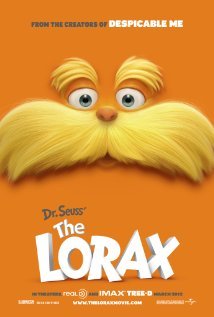Dr Suess’ The Lorax is the latest children’s CGI blockbuster to hit theaters in 3-D this winter, and it may be worth the hefty ticket price for most Suess enthusiasts and for those of you who can’t get enough of the deep screen experience. I opted for the 2-D version this time. There are several scenes that were set up perfectly for the cutting edge technology, like the Once-lers (Ed Helms) arms poking out at us through a boarded window of his isolated tower, but nothing essential to the story will be missed in 2-D compared to 3-D.
This is director Chris Renauld’s and writer Ken Daurio’s (2010 Despicable me) second attempt to adapt a Suess classic into an animated feature film. The 2008 hit Horton Hears a Who was the first, and in my opinion, a much better film by the duo. Some may argue that this is because Horton is the stronger of the two books, but I think that the fact that Renauld and Duario took more liberties with the story and characters in the Lorax may have a lot to do with it.
In Horton, the set and character design were spot on; so much so that every frame looked as though it could have been pulled straight from the page into that slick looking computer generated universe. Dr. Suess’ the Lorax on the other hand, only borrows from Suess’ iconic style and incorporates those elements into their own version of the vibrant, yet sterile Thneedville.
Some Suess fans will likely be turned off by the fact that, at first glance, Lorax doesn’t look like a Dr. Suess book, but most will likely warm up to the new hybrid of styles used here. The designers and animators managed to create a world all their own that is stylistically very cool; combining photo realistic structures and almost tactile textures with surreal dreamlike landscapes. Gone however are the characteristic colorful and almost squishy looking organic shapes most would typically associate with the children’s books. For example, you may notice that a building in the background and pavement of the street look as if they are made of actual stone and asphalt, but the road itself follows a whimsical serpentine line that only Suess would have us travel.
The few gripes I do have about the movie didn’t exactly ruin the experience for me and for some, I’m sure, these could even possibly be their favorite parts. The movie is peppered with several cheesy musical numbers done in complete Glee fashion with the whole town breaking into song and dance. This in its self is fine, but the songs are completely forgettable and poorly produced. They almost sound like a 99-cent children’s pop cd you could pick up in the checkout line at Toys-R-Us. It’s disappointing considering the vocal talent headlining the lead rolls. I believe that the songs where used as filler for time more than anything else. You will not leave the theater humming any of these tunes.
The other main shortcoming was the cast of saccharin sweet woodland animals that populate every flashback scene. These are the creatures that a young Once-ler befriends after he sets out to manufacture a useful invention he has envisioned in an attempt to make a name for himself. The animals, whom are more than a little annoying at times and only mildly entertaining at others, are cute, but offer little more to the movie than a few cheap sight gags. Of course I realize that I am not the target demographic for this film, and the fuzzy faced animals did incite several giggles and snorts from the youngest in attendance that night.
The title character, the Lorax (Danny DiVitto), appears after the Once-ler cuts down the first tree in order to harvest the soft truffula tuft growing atop it; a pillowy wisp of cotton-like fibers needed to fabricate his precious invention the thneed. The Lorax proclaims that he “speaks for the trees” and asks that if Once-ler is going to make his thneeds, that he not cut down any more trees to do so. DiVitto as the Lorax is brilliant and steals every scene he is in, with his gruff little voice and impeccable comedic performance. All goes well until the Once-ler’s greedy family catches wind of how popular his thneeds are becoming and decide they must cut the trees down to manufacture thneeds more quickly.
Cut to many years later, after every Truffula Tree has been cut down, and we meet our main characters Ted (Zach Effron) and Audry (Taylor Swift). These characters are not in the book, and their budding love story is the vehicle that drives this story. This casting choice is most likely behind the High School Musical vibe I got and must have made a lot of sense on paper. There is a devoted fan base for the genre, so I can’t blame anyone for trying to tap that market. The only problem I have with this is that Dr. Suess wanted to make a statement about eco-conscientiousness with the Lorax, but his message is nearly lost at times and plays only a supporting role in the film.
Overall, Dr. Suess’ the Lorax is good wholesome family entertainment and a visual treat. This is a loose interpretation of the classic children’s book, but it manages to hold its own and entertain while attempting to deliver a poignant message in a glossy and formulaic package. There is something here to be enjoyed by everyone, young and old. If you don’t have much extra change, I would definitely recommend skipping the 3-D version as you will not be missing much. Besides, those bulky glasses can be distracting and could prevent the younger audience members from taking home the important lessons about conservation and eco-conscientiousness the good Doctor wanted to convey in the first place.









